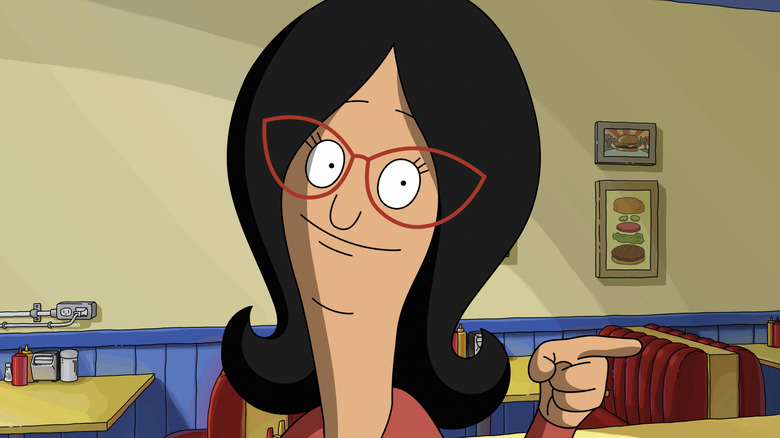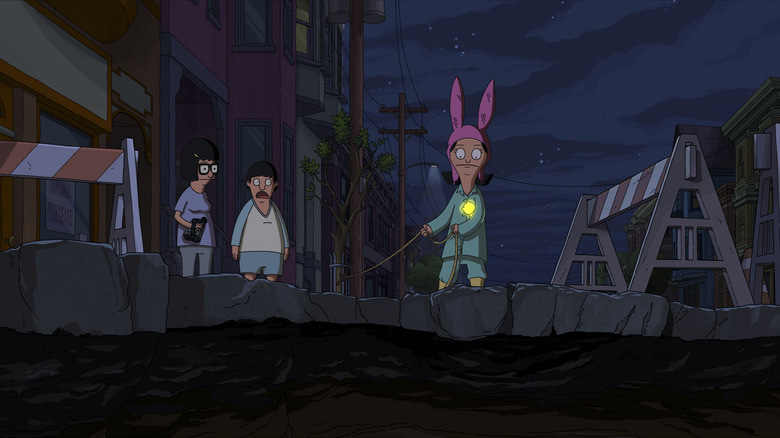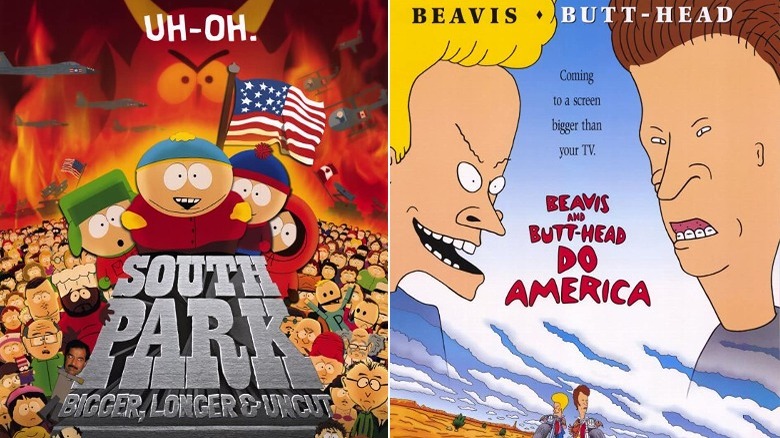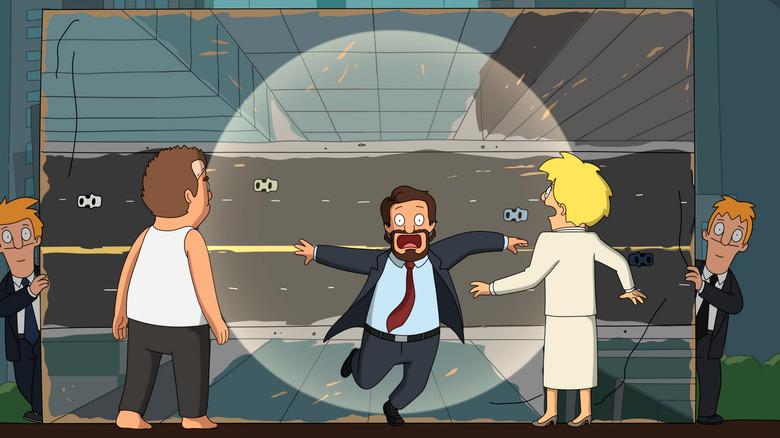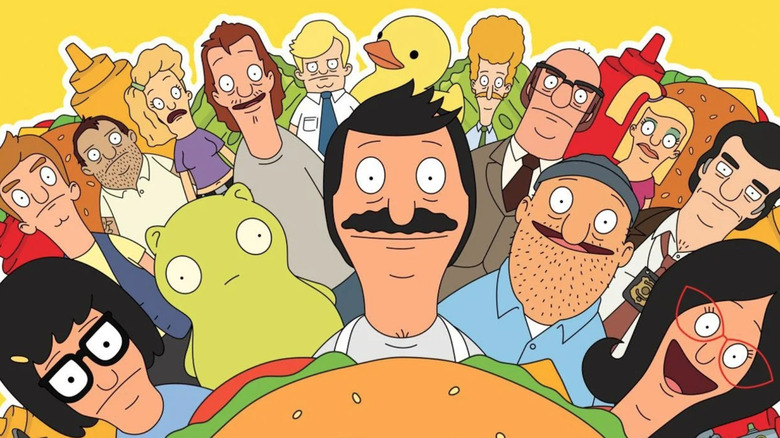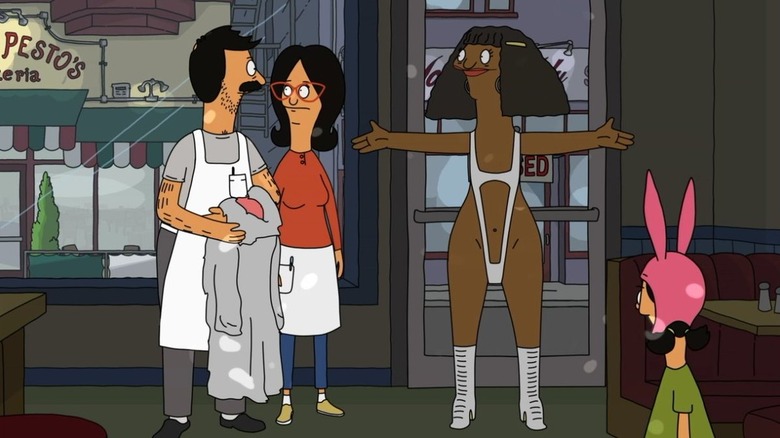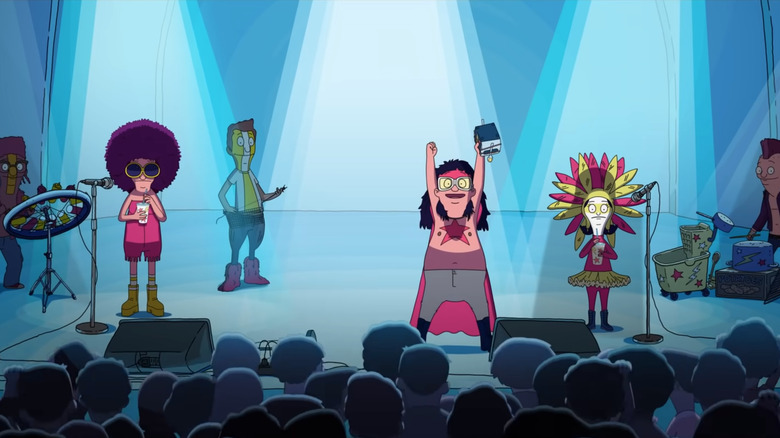How Loren Bouchard, Bernard Derriman, And Nora Smith Brought Bob's Burgers To The Big Screen - Exclusive Interview
"Bob's Burgers" has stood out as one of the more modest adult animated comedies on the air. More grounded in reality than "The Simpsons" and nowhere near the crude absurdity of most Adult Swim shows, it's a sitcom that's found humor and relatability in lives of a quirky yet supportive working class family managing a struggling business. The formula has been successful on television for 12 seasons and counting, but could it translate into an exciting summer movie?
As it turns out, the answer is a resounding "yes." A worthy expansion of the show, "The Bob's Burgers Movie" tells a bigger story that couldn't work as a single episode while still staying true to the series' sensibility. Looper got the chance to speak with Loren Bouchard (the series' creator and the film's co-writer, co-producer, and co-director), Nora Smith (the film's co-writer and co-producer), and Bernard Derriman (the film's co-director) about the process of bringing "Bob's Burgers" to the big screen. Our talk touched upon the movie's "genre shopping" story, handling musical numbers and fan-favorite characters, and why audiences should support the art of traditional animation.
A murder mystery, Bob's Burgers-style
I had no idea going into the movie that it was going to be a murder mystery. How would you decide on that as the focus?
Nora Smith: As soon as we knew that we were allowed to make a movie, we are like, "Can we make it a murder mystery?" Because it's a genre that we all really like a lot, and also, it's something that we couldn't really do on the TV show because it didn't quite feel right. On a big screen, you felt like we could make it work. That was something we got excited about pretty early on, and seeing how we could make that fit that genre into a "Bob's"-esque thing.
Loren Bouchard: Yeah, we went genre shopping. We took a little from murder mystery. We took a little from musical. We took a little from action adventure. It was really fun to go and pick out a couple outfits, so to speak, and try them on. That one felt like a fit from the very beginning.
Were there any particular mystery films or stories you looked to for inspiration?
Bouchard: Hmm. That's a good question. We looked at all of them at one point or another, and then, at a certain point, we also had to throw them away. One part of what genre shopping gets you is that you can jump out of it too, and we knew we had to tell, first and foremost, we had to tell an emotional story for each one of those characters. They couldn't — it couldn't be Louise solves a mystery and has a journey of her own [and] everyone else is a supporting player. It had to be: Each character will face their worst fear and come out better for it on the other side.
In some ways, we would've been too locked in if we had sleepovers and we all watched mysteries together, ate popcorn. We would've gotten too high bound by the conventions of the genre. That's a very rigid genre, when you're doing it straight up. We sampled the little parts that we knew we needed, a couple red herrings and things like that, but we wanted to also leave room for the characters.
Past series-to-movie adaptations done right
Were there any past movie adaptations of TV shows that you looked to as an example of how to do this right?
Smith: Good question. I don't know if I've seen any.
Bernard Derriman: We didn't necessarily look at other films that had started off as a series, but I was always conscious of the successful ones and what made them work. I still go back to "Beavis and Butt-Head" as a show that was very small, but they managed to do it, make it a big screen event in a great way. It felt like it was something that I thought they did a really good job at doing so well. That was always — it was good to know people have done it before.
Bouchard: Yeah. We couldn't steal their tricks, but "South Park" did the same. They really made a spectacle. If you were going to see the "South Park" movie, it was made for the big screen and it felt worth your time to go find it at a movie theater. We couldn't do any of what they did, but we knew that feeling was important. You can't leave people feeling like it was just a long episode of "Bob's." It had to be something worthy of seeing in the theater.
How Bob's Burgers grows more and more musical
There are three big song and dance numbers in the film. I'm not sure if that counts as a full-blown musical, but the numbers themselves are very ambitious, and in some ways closer to those in your musical series, "Central Park." Did your work on "Central Park" influence "The Bob's Burgers Movie"?
Smith: Maybe choreography wise, a little bit.
Yeah, that was the main way I was thinking, the choreography felt like "Central Park."
Smith: As a tool, we could use a little more than we've used in the show, perhaps.
Bouchard: We're excited about musicals in a way that has built on itself year after year, for sure. We started getting more ambitious on the series as we went. We had our big swings, like "Topsy" and ["Work Hard or Die Trying, Girl"]. Those were episodes where I was like, "What if we had a few songs," especially with "Work Hard."
That is why we said yes to "Central Park." It was because we started to appreciate, more and more, what animation and music and dancing in particular can do for an audience, and how much fun it is for us to make. Bernard is by far, in my opinion, the greatest drawer of dancing that I can imagine. He gets something, both musical and rhythmic and fluid, but also funny into these movements. It is fun to give him a sandbox to play in. In the end, there's four big musical numbers in this movie. We wanted to leave them dancing in the aisles, so we really tried to finish with a piece of music that left you hopefully as happy as our end credits do on the series.
Avoiding a constant cameo-fest
This movie has been in the works for so long that when you started production, Jimmy Pesto was still a series regular. In the finished film, he appears, but doesn't talk for obvious reasons. Did he have a bigger role in earlier drafts of the script?
Bouchard: Not really. No. They're all of our characters at one point or another. We tried them on to see if they could be in the movie and how much they could be in the movie. What we've said to ourselves many times is, we had a choice to make, whether it was going to be a bunch of cameos or whether it was going to be the best movie we could make and they are in conflict. They really are.
You can give the fans all their fan favorite characters, and some of the controversial ones too, but you can't do that and tell a proper story. You run out of minutes. There were a lot of characters who might have had a line or two, and that got shrunk down. Some of them came out easier than others.
Preparing for Marshmallow's eventual return
Another character who appears briefly but doesn't have any lines in the movie is Marshmallow. Two years ago, Loren mentioned that Marshmallow was being recast, but this recasting has yet to be announced. Will we be seeing more of her in the future?
Bouchard: Yeah. We'd love to recast. We are still finding our Marshmallow and we are still excited to do that. That character means a lot, and we love when a character means something. It feels a little like handling a live wire, and it's a little bit humbling when you find out that this character means more than a vehicle for a writer to write a funny line and walk in and walk out. That's a character that means something.
Smith: The writers really love Marshmallow. We want to get it right.
Bouchard: So do the animators, so do the board artists, so do the designers, right.
Smith: It's almost like a challenge to all the staffed writers, like who can come up with the best reentrance of Marshmallow. It's a challenge for ourselves.
Celebrating 2D animation in theaters
"The Bob's Burgers Movie" is the first American 2D animated film released theatrically in quite a while. What does the future of 2D animation in theaters look like to you?
Bouchard: I like all your questions, by the way.
Derriman: I love 2D. I started at Disney and I've animated all my career, straight out of high school. I'm a big fan of 2D and I'd love to see more of it. Hopefully ... if people go and see it, others might follow [and] start getting back into 2D. It would be great.
Bouchard: Here's my argument to the audience: When you're watching 2D animation, whether it's in a movie theater or on TV, what you're seeing is a bunch of artists making a lot of decisions about what not to include. 2D animation is, by definition, somewhat more minimal. It doesn't have to be simple, but it's reducing the world to a line drawing with some color. It's a fascinating process. I'm no artist, but I love artists, and I love seeing their decision-making process. If we draw a background for a 2D-animated movie, you're going to see a bunch of detail. You're going to see shadows and cracks in the sidewalk because we love that stuff, but at all points, something is also being left out. Some decision has been made, and this is true of 3D, too.
I'm sure there are great CG background designers out there who are saying, "Hey, I leave stuff out of my backgrounds too," but I would argue that CG puts back in that true perspective and that real world, the camera's going to swoosh through the streets and you're going to see all the reflections, and now they've got all the hairs beautifully rendered and everything moves in this virtual wind. I respect it and I enjoy those movies too, but I really hope that the art and craft of 2D animation, especially at that higher level, that theatrical level, continues because I want to see what the next generation of 2D animators comes up with. It's a really fantastic medium, and I hope it makes a resurgence. I'll watch anyway.
Smith: And you said before you feel the artist's hand in a way that feels more of a connection with it.
Bouchard: Yeah, absolutely. And again, I'm sure the CG people would say, "Hey, I know we're artists." ... But when Bernard draws the first drawing, the thumbnail that you're going to put in a storyboard, something of that drawing stays all the way through till the end. Even though it's been cleaned up, it's still his drawing.
There's been a movement in some CG films recently, like "Spider-Man: Into the Spider-Verse" and "The Mitchells Vs. The Machines," where they layer drawings on top of 3D characters.
Bouchard: Yeah, they're hungering for the same thing we all are maybe, which is to vary the look, to not have each giant budget four-quadrant family animated movie look the same as the other, and again, no offense to our friends who are working in CG. I'm sure they are differentiating themselves from each other, but there's a great bunch of 2D animated movies out there waiting to be born now that I hope get a chance.
"The Bob's Burgers Movie" opens in theaters May 27.
